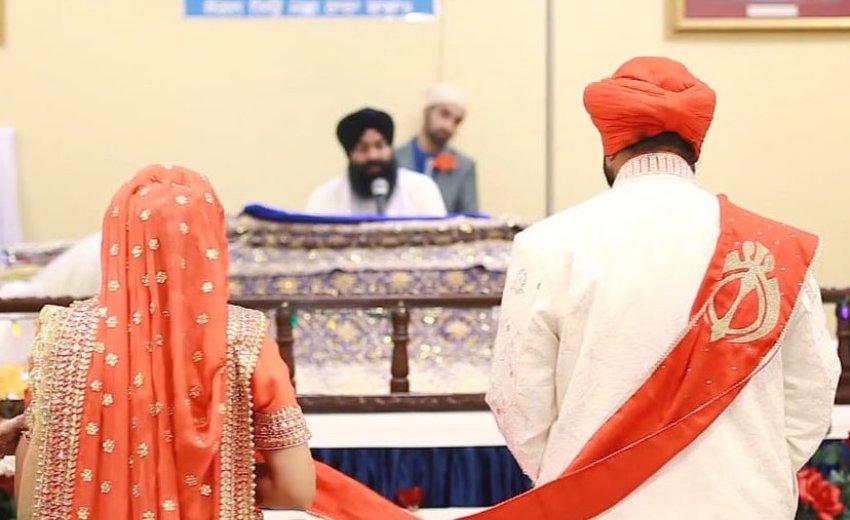Anand Karaj is the traditional Sikh marriage ceremony, symbolizing the equal partnership between two individuals.
Sikhism has its own tradition of celebrating and commemorating different occasions. There are various ceremonies that mark significant milestones in one's life, such as Naam Karna (naming ceremony), Dastar Bandi (turban tying), Charni Lagna (starting a reading of the Guru Granth Sahib), Amrit Sanchar (becoming initiated into the Khalsa), and Antam Sanskar (funeral ceremony). These ceremonies are opportunities to remember Waheguru, celebrate within the community (Sadh Sangat), and support individuals on their Sikh path. One notable occasion among these is the Anand Karaj.
Anand Karaj
Anand Karaj is the traditional Sikh marriage ceremony, symbolizing the equal partnership between two individuals. The term translates to "blissful union." In Sikhism, marriage holds not only physical, social, and legal significance but also a deep spiritual connection. It represents the sacred union of two souls with the Guru at the center. As stated in the Guru Granth Sahib that they are not said to be husband and wife, who merely sit together. They alone are called husband and wife, who have one light in two bodies. Marriage serves as a path towards understanding Waheguru and attaining spiritual enlightenment.
According to Waheguru Net, "Marriage is a spiritual journey, not just a love affair between two people. A Sikh marriage is two people trying to help one another in their merger with God. The highest love is assisting another in the merger of the soul with the infinite (God), helping their beloved to find the true purpose of their life."
In Sikhism, marriage is viewed as a sacred union aimed at achieving both worldly fulfilment and spiritual enlightenment. It's seen as a merging of minds and souls, a path towards spirituality rather than an end in itself. The ultimate aim of marriage is seen as the union of both partners' souls with Waheguru, as stated in Sikh Studies (1995).
During the Anand Karaj ceremony, the couple acknowledges Guru Granth Sahib as their spiritual guide and commits to continuing their journey towards the Divine. Circling around Guru Granth Sahib symbolizes its centrality in their lives, with the supportive community represented by the sadh sangat. Furthermore, the couple pledges to assist each other in delving deeper into spiritual realms, aiming for a more profound union with Waheguru, according to the Sikh Research Institute (2008).
Lavan
According to the Sikh Research Institute (2008), the Sikh marriage ceremony symbolizes a profound union, mirroring the merging of the human soul with the Supreme Being. This union transcends the physical realm and signifies the shedding of individual egos for a higher unity, where two individuals become one. The process of this union, both between husband and wife and between the soul and Waheguru, is illustrated in the "lava," or wedding hymns, sung during the Sikh wedding ceremony.
Also, Guru Ramdas Ji, the fourth Guru, originally composed the "Lavan," known as the wedding song, found in the Guru Granth Sahib on page 773. It was created to commemorate the union between the human soul (atma) and God (parmatma).
The Lavan offers Sikhs a guide for a happy marriage, portraying the sacred union of the soul with the Infinite. Applied to marriage, it leads to joy and satisfaction. During the ceremony, the couple circles the Guru, pledging to Waheguru with each round, while the Guru serves as the witness. This act symbolizes that Waheguru is the core of their lives, providing them with support and comprehension throughout their spiritual journey together.
History of Sikh Marriages
Many believe Guru Nanak Sahib established the initial Sikh wedding ceremony. According to tradition, Guru Nanak Sahib declined to marry through the traditional Hindu Vedi ceremony, causing controversy. Instead, he placed an inscription of the Mul Mantar on a stool and circled it with his bride, Mata Sulakkhani, during their wedding. Later, Guru Amar Das introduced the Anand marriage, composing Anand Sahib and officiating marriages by singing it alongside an Ardas. The Lavan was created by the fourth Guru, Guru Ramdas Sahib, and became the standard composition sung during Sikh weddings, a practice that persists today.
Early Sikh Marriages
Early Sikh marriage customs were not well-documented in history until the Singh Sabha Movement emerged in the early 19th century. It shed light on the Hindu and Brahmanical rituals that influenced Sikh marriage ceremonies in the 1800s. According to a historical account, Sikh marriages were previously conducted similarly to Hindu rituals, with Brahmins officiating but with hymns from the Fourth Guru replacing Hindu songs. Later, a dual ceremony was adopted where Hindu rites were performed first, followed by the couple circling the Granth Sahib four times while Sikh priests recited Lavan hymns. Some Sikhs also practiced alternate leading during the phere around a fire, with the bridegroom leading four times and the bride leading three times. However, these practices evolved with the advent of the Singh Sabha Movement.
Present day Sikh Marriages
During the 1800s, the Singh Sabha Movement, along with the Nirankari and Namdhari movements, played a significant role in reshaping the Anand Karaj ceremony. These movements aimed to eliminate rituals and Hindu customs from the marriage ceremony. The Nirankaris and Namdharis introduced new marriage practices that rejected the involvement of Brahmins and the tradition of dowry among Sikhs in the mid-eighteenth century. Some scholars suggest that it was the Nirankaris who reintroduced the custom of circling the Guru Granth Sahib.
In the early to mid-1900s, the authors of the Rehit Maryada sought to establish an Anand Karaj ceremony aligned with Gurmat principles and reflective of Sikh sovereignty, aiming to recreate what they believed the Gurus practiced. The ceremony we witness today, where the groom leads the bride around the Guru Granth Sahib four times during the singing of the Lavan hymns, was standardized by the Sikh Rehit Maryada in 1950.
*Based on an article published in Kaur Life on 22nd April 2015

